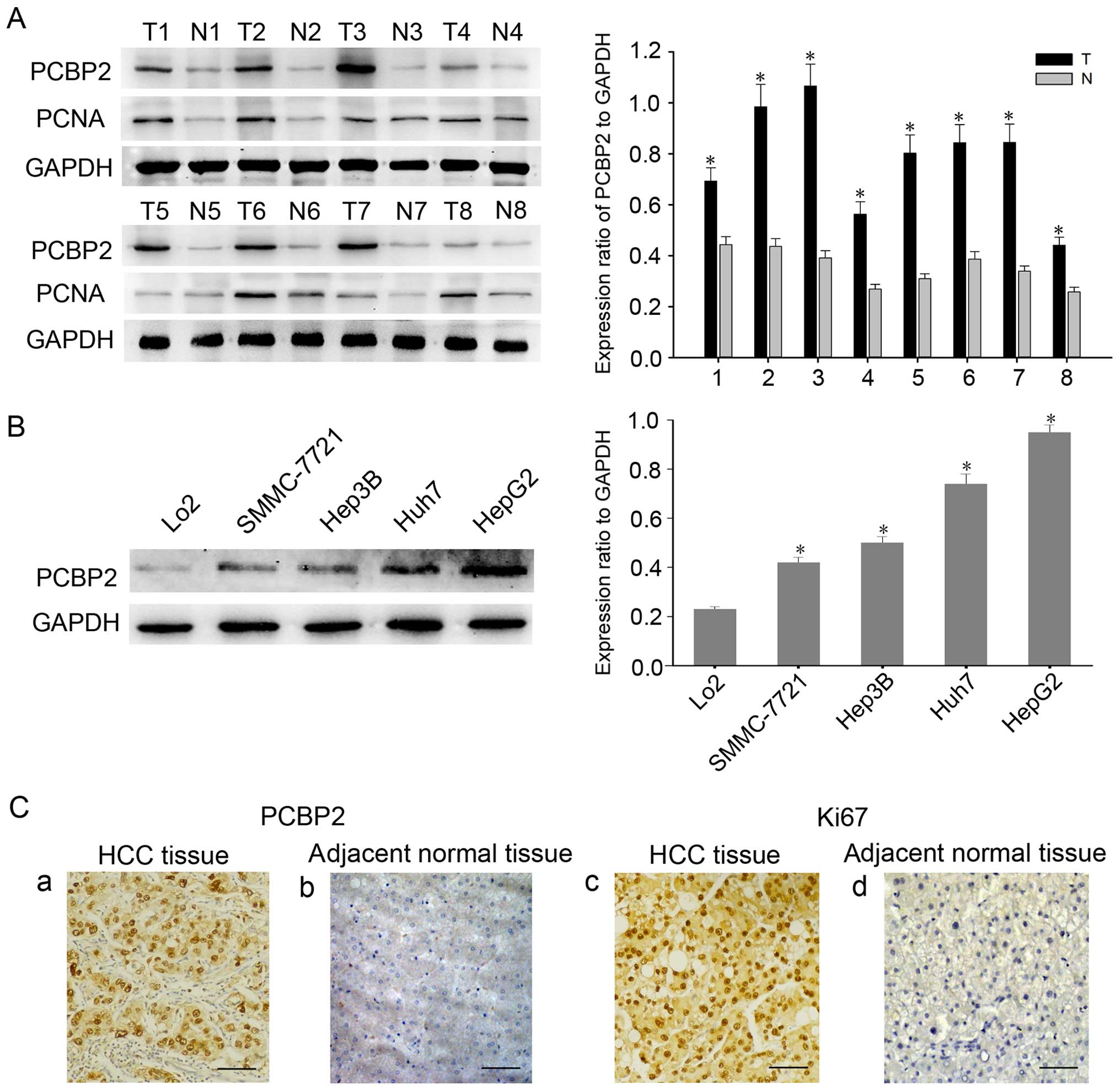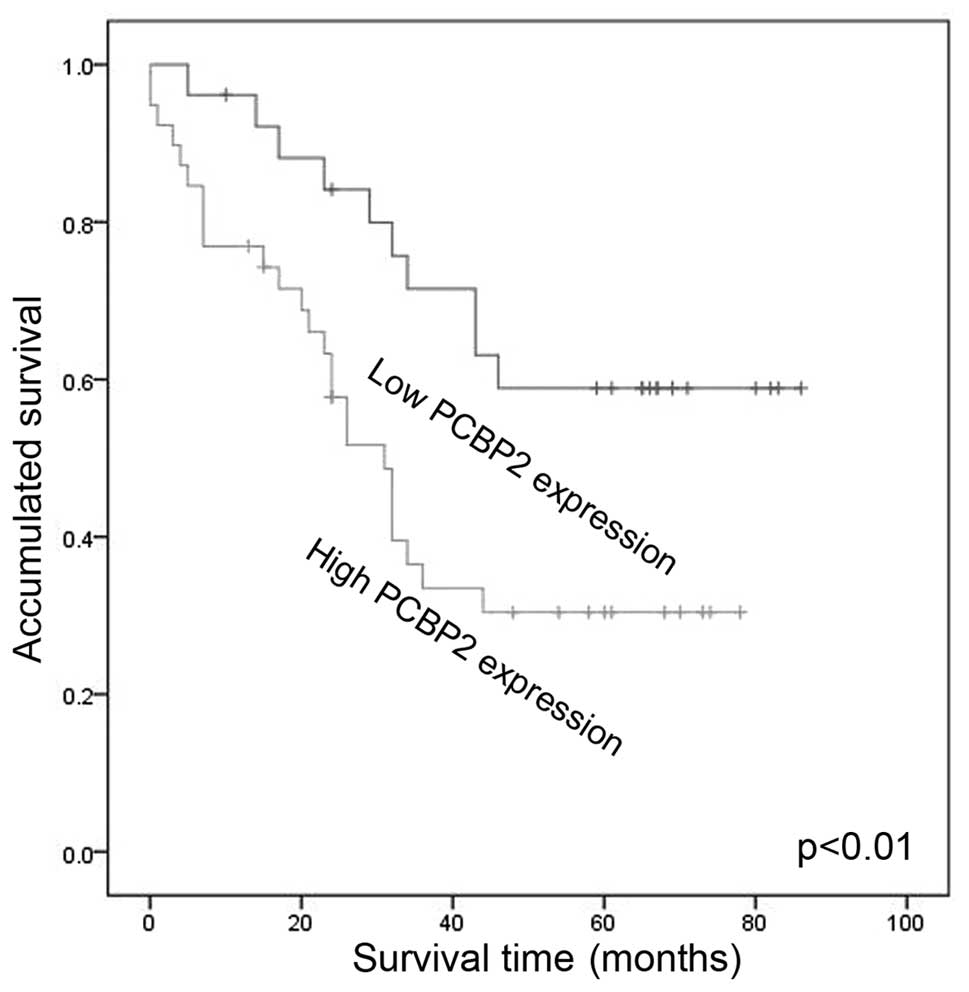|
1
|
Tsochatzis EA, Meyer T and Burroughs AK:
Hepatocellular carcinoma. N Engl J Med. 366:92–93; author reply
92–93. 2012. View Article : Google Scholar : PubMed/NCBI
|
|
2
|
Malek NP, Schmidt S, Huber P, Manns MP and
Greten TF: The diagnosis and treatment of hepatocellular carcinoma.
Dtsch Arztebl Int. 111:101–106. 2014.PubMed/NCBI
|
|
3
|
Llovet JM, Burroughs A and Bruix J:
Hepatocellular carcinoma. Lancet. 362:1907–1917. 2003. View Article : Google Scholar : PubMed/NCBI
|
|
4
|
Finn RS: Development of molecularly
targeted therapies in hepatocellular carcinoma: Where do we go now?
Clin Cancer Res. 16:390–397. 2010. View Article : Google Scholar : PubMed/NCBI
|
|
5
|
Andino R, Böddeker N, Silvera D and
Gamarnik AV: Intracellular determinants of picornavirus
replication. Trends Microbiol. 7:76–82. 1999. View Article : Google Scholar : PubMed/NCBI
|
|
6
|
Blyn LB, Towner JS, Semler BL and
Ehrenfeld E: Requirement of poly(rC) binding protein 2 for
translation of poliovirus RNA. J Virol. 71:6243–6246.
1997.PubMed/NCBI
|
|
7
|
Collier B, Goobar-Larsson L, Sokolowski M
and Schwartz S: Translational inhibition in vitro of human
papillomavirus type 16 L2 mRNA mediated through interaction with
heterogenous ribonucleoprotein K and poly(rC)-binding proteins 1
and 2. J Biol Chem. 273:22648–22656. 1998. View Article : Google Scholar : PubMed/NCBI
|
|
8
|
Tang FM, Li WM, Chen Y, Wang DM and Han J:
Expression of hnRNP K in lung adenocarcinoma cells. Sichuan Da Xue
Xue Bao Yi Xue Ban. 39:823–826. 2008.(In Chinese). PubMed/NCBI
|
|
9
|
He Y, Brown MA, Rothnagel JA, Saunders NA
and Smith R: Roles of heterogeneous nuclear ribonucleoproteins A
and B in cell proliferation. J Cell Sci. 118:3173–3183. 2005.
View Article : Google Scholar : PubMed/NCBI
|
|
10
|
Zhou ZJ, Dai Z, Zhou SL, Fu XT, Zhao YM,
Shi YH, Zhou J and Fan J: Overexpression of HnRNP A1 promotes tumor
invasion through regulating CD44v6 and indicates poor prognosis for
hepatocellular carcinoma. Int J Cancer. 132:1080–1089. 2013.
View Article : Google Scholar : PubMed/NCBI
|
|
11
|
Liu Y, Gai L, Liu J, Cui Y, Zhang Y and
Feng J: Expression of poly(C)-binding protein 1 (PCBP1) in NSCLC as
a negative regulator of EMT and its clinical value. Int J Clin Exp
Pathol. 8:7165–7172. 2015.PubMed/NCBI
|
|
12
|
Sean P, Nguyen JH and Semler BL: The
linker domain of poly(rC) binding protein 2 is a major determinant
in poliovirus cap-independent translation. Virology. 378:243–253.
2008. View Article : Google Scholar : PubMed/NCBI
|
|
13
|
Sean P, Nguyen JH and Semler BL: Altered
interactions between stem-loop IV within the 5′ noncoding region of
coxsackievirus RNA and poly(rC) binding protein 2: Effects on
IRES-mediated translation and viral infectivity. Virology.
389:45–58. 2009. View Article : Google Scholar : PubMed/NCBI
|
|
14
|
Molinaro RJ, Jha BK, Malathi K, Varambally
S, Chinnaiyan AM and Silverman RH: Selection and cloning of
poly(rC)-binding protein 2 and Raf kinase inhibitor protein RNA
activators of 2′,5′-oligoadenylate synthetase from prostate cancer
cells. Nucleic Acids Res. 34:6684–6695. 2006. View Article : Google Scholar : PubMed/NCBI
|
|
15
|
Han W, Xin Z, Zhao Z, Bao W, Lin X, Yin B,
Zhao J, Yuan J, Qiang B and Peng X: RNA-binding protein PCBP2
modulates glioma growth by regulating FHL3. J Clin Invest.
123:2103–2118. 2013. View
Article : Google Scholar : PubMed/NCBI
|
|
16
|
Lin X, Yang B, Liu W, Tan X, Wu F, Hu P,
Jiang T, Bao Z, Yuan J, Qiang B, et al: Interplay between PCBP2 and
miRNA modulates ARHGDIA expression and function in glioma migration
and invasion. Oncotarget. 7:19483–19498. 2016.PubMed/NCBI
|
|
17
|
Hu CE, Liu YC, Zhang HD and Huang GJ: The
RNA-binding protein PCBP2 facilitates gastric carcinoma growth by
targeting miR-34a. Biochem Biophys Res Commun. 448:437–442. 2014.
View Article : Google Scholar : PubMed/NCBI
|
|
18
|
Wan C, Gong C, Zhang H, Hua L, Li X, Chen
X, Chen Y, Ding X, He S, Cao W, et al: β2-adrenergic receptor
signaling promotes pancreatic ductal adenocarcinoma (PDAC)
progression through facilitating PCBP2-dependent c-myc expression.
Cancer Lett. 373:67–76. 2016. View Article : Google Scholar : PubMed/NCBI
|
|
19
|
Fukushi S, Okada M, Kageyama T, Hoshino
FB, Nagai K and Katayama K: Interaction of poly(rC)-binding protein
2 with the 5′-terminal stem loop of the hepatitis C-virus genome.
Virus Res. 73:67–79. 2001. View Article : Google Scholar : PubMed/NCBI
|
|
20
|
Tingting P, Caiyun F, Zhigang Y, Pengyuan
Y and Zhenghong Y: Subproteomic analysis of the cellular proteins
associated with the 3′ untranslated region of the hepatitis C virus
genome in human liver cells. Biochem Biophys Res Commun.
347:683–691. 2006. View Article : Google Scholar : PubMed/NCBI
|
|
21
|
Wang L, Jeng KS and Lai MM:
Poly(C)-binding protein 2 interacts with sequences required for
viral replication in the hepatitis C virus (HCV) 5′ untranslated
region and directs HCV RNA replication through circularizing the
viral genome. J Virol. 85:7954–7964. 2011. View Article : Google Scholar : PubMed/NCBI
|
|
22
|
Shukla RS, Qin B, Wan YJ and Cheng K:
PCBP2 siRNA reverses the alcohol-induced pro-fibrogenic effects in
hepatic stellate cells. Pharm Res. 28:3058–3068. 2011. View Article : Google Scholar : PubMed/NCBI
|
|
23
|
Leidgens S, Bullough KZ, Shi H, Li F,
Shakoury-Elizeh M, Yabe T, Subramanian P, Hsu E, Natarajan N,
Nandal A, et al: Each member of the poly-r(C)-binding protein 1
(PCBP) family exhibits iron chaperone activity toward ferritin. J
Biol Chem. 288:17791–17802. 2013. View Article : Google Scholar : PubMed/NCBI
|
|
24
|
Wang Y, Wang Y, Xiang J, Ji F, Deng Y,
Tang C, Yang S, Xi Q, Liu R and Di W: Knockdown of CRM1 inhibits
the nuclear export of p27(Kip1) phosphorylated at serine 10 and
plays a role in the pathogenesis of epithelial ovarian cancer.
Cancer Lett. 343:6–13. 2014. View Article : Google Scholar : PubMed/NCBI
|
|
25
|
Wang Y, Liu F, Mao F, Hang Q, Huang X, He
S, Wang Y, Cheng C, Wang H, Xu G, et al: Interaction with cyclin
H/cyclin-dependent kinase 7 (CCNH/CDK7) stabilizes C-terminal
binding protein 2 (CtBP2) and promotes cancer cell migration. J
Biol Chem. 288:9028–9034. 2013. View Article : Google Scholar : PubMed/NCBI
|
|
26
|
Akiba N, Hayakawa I, Keh ES and Watanabe
A: Antifungal effects of a tissue conditioner coating agent with
TiO2 photocatalyst. J Med Dent Sci. 52:223–227.
2005.PubMed/NCBI
|
|
27
|
Cragg MS and Glennie MJ: Antibody
specificity controls in vivo effector mechanisms of anti-CD20
reagents. Blood. 103:2738–2743. 2004. View Article : Google Scholar : PubMed/NCBI
|
|
28
|
Cheng AL, Kang YK, Chen Z, Tsao CJ, Qin S,
Kim JS, Luo R, Feng J, Ye S, Yang TS, et al: Efficacy and safety of
sorafenib in patients in the Asia-Pacific region with advanced
hepatocellular carcinoma: A phase III randomised, double-blind,
placebo-controlled trial. Lancet Oncol. 10:25–34. 2009. View Article : Google Scholar : PubMed/NCBI
|
|
29
|
Llovet JM, Ricci S, Mazzaferro V, Hilgard
P, Gane E, Blanc JF, de Oliveira AC, Santoro A, Raoul JL, Forner A,
et al: SHARP Investigators Study Group: Sorafenib in advanced
hepatocellular carcinoma. N Engl J Med. 359:378–390. 2008.
View Article : Google Scholar : PubMed/NCBI
|
|
30
|
Okuda K, Ohtsuki T, Obata H, Tomimatsu M,
Okazaki N, Hasegawa H, Nakajima Y and Ohnishi K: Natural history of
hepatocellular carcinoma and prognosis in relation to treatment.
Study of 850 patients. Cancer. 56:918–928. 1985. View Article : Google Scholar : PubMed/NCBI
|
|
31
|
Rahbari NN, Mehrabi A, Mollberg NM, Müller
SA, Koch M, Büchler MW and Weitz J: Hepatocellular carcinoma:
Current management and perspectives for the future. Ann Surg.
253:453–469. 2011. View Article : Google Scholar : PubMed/NCBI
|
|
32
|
Eiring AM, Harb JG, Neviani P, Garton C,
Oaks JJ, Spizzo R, Liu S, Schwind S, Santhanam R, Hickey CJ, et al:
miR-328 functions as an RNA decoy to modulate hnRNP E2 regulation
of mRNA translation in leukemic blasts. Cell. 140:652–665. 2010.
View Article : Google Scholar : PubMed/NCBI
|
|
33
|
Koganti S, Clark C, Zhi J, Li X, Chen EI,
Chakrabortty S, Hill ER and Bhaduri-McIntosh S: Cellular STAT3
functions via PCBP2 to restrain Epstein-Barr Virus lytic activation
in B lymphocytes. J Virol. 89:5002–5011. 2015. View Article : Google Scholar : PubMed/NCBI
|
|
34
|
Midorikawa Y, Yamamoto S, Ishikawa S,
Kamimura N, Igarashi H, Sugimura H, Makuuchi M and Aburatani H:
Molecular karyotyping of human hepatocellular carcinoma using
single-nucleotide polymorphism arrays. Oncogene. 25:5581–5590.
2006. View Article : Google Scholar : PubMed/NCBI
|
|
35
|
Luo X and Feng GS: VEGFA genomic
amplification tailors treatment of HCCs with sorafenib. Cancer
Discov. 4:640–641. 2014. View Article : Google Scholar : PubMed/NCBI
|














